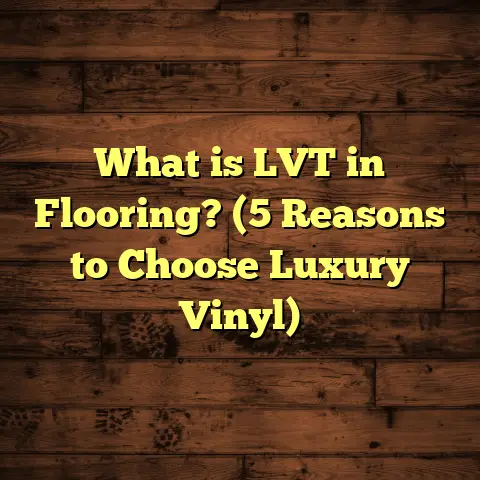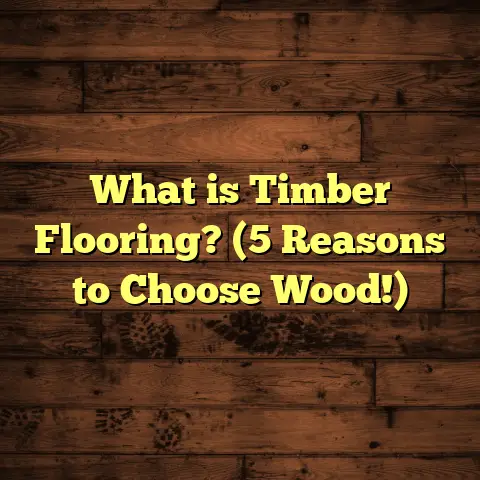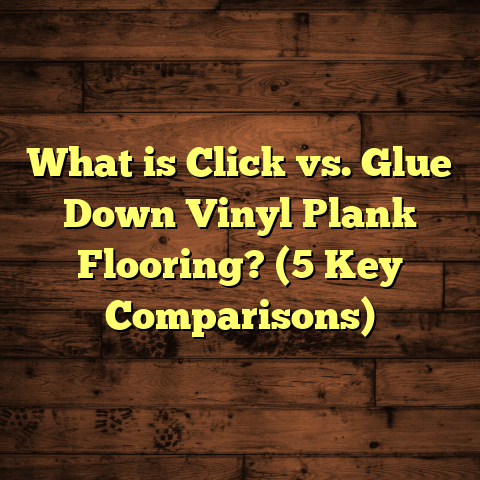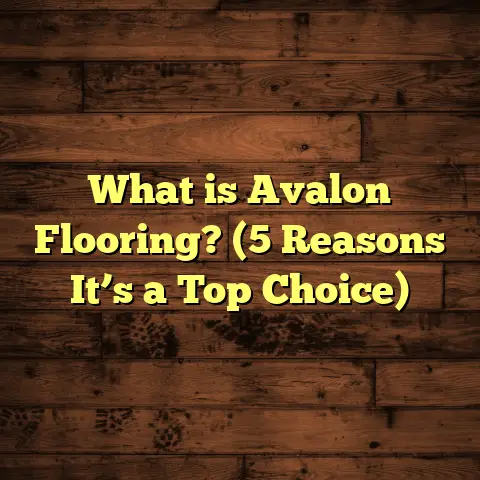What is Wood Effect Flooring? (5 Benefits for Your Home)
A lot of people think wood flooring means one thing—solid hardwood. But that’s actually a pretty common mistake I see again and again. When someone mentions wood floors, most immediately picture those expensive, delicate planks that require tons of upkeep. But guess what? That’s not the only way to get that warm, inviting wood look. Wood effect flooring has become a serious game-changer for homeowners who want the beauty of wood but with fewer hassles and a friendlier price tag. I’ve been working in flooring for years, and I want to share everything I’ve learned about why wood effect flooring might just be the perfect fit for your home.
What Is Wood Effect Flooring?
Wood effect flooring is exactly what it sounds like—a type of flooring designed to look like natural wood. But instead of being made from solid timber, it’s crafted from other materials like vinyl, laminate, or even tile. These materials have been engineered and printed with highly realistic wood grain patterns and textures that give you the same warm, natural appearance without some of the downsides that hardwood floors come with.
I think of wood effect flooring as a smart alternative that blends style and practicality. It’s perfect if you love the look of wood but are looking for something more affordable, durable, or easier to care for. Over the last decade, advancements in manufacturing technology have made these floors look so close to the real thing that many people can’t tell the difference.
Different Types of Wood Effect Flooring I Work With
I usually categorize wood effect flooring into several popular types. Each has its strengths and fits different needs:
- Laminate Flooring: This is made of several layers—an HDF (high-density fiberboard) core, topped by a photographic layer that mimics wood grain, covered by a clear protective surface. It’s popular because it’s affordable and relatively easy to install.
- Luxury Vinyl Planks (LVP): Vinyl planks are made from multiple layers of vinyl and other polymers. They are waterproof, which makes them perfect for kitchens, bathrooms, or basements. The printing technology here has improved a lot; modern LVP looks very realistic.
- Wood Effect Tiles: These are ceramic or porcelain tiles designed to look like wood planks. They’re extremely durable and waterproof, so they’re great in wet areas or high-traffic zones.
- Engineered Wood: This is technically real wood but constructed with layers—thin slices of real wood on top of plywood or HDF bases. It gives you some benefits of hardwood but with better stability.
Understanding these options has helped me guide clients toward what works best for their home conditions and budgets.
Why I Recommend Wood Effect Flooring: 5 Benefits for Your Home
From my years installing floors in all sorts of homes—from urban apartments to family houses—wood effect flooring offers advantages that often outweigh traditional hardwood. Let me walk you through five benefits that stand out for me.
1. Affordable Style Without Compromise
One of the biggest reasons people hesitate to go with hardwood is cost. Real hardwood is expensive—not just materials but installation too. The average cost of solid hardwood flooring runs from $8 to $15 per square foot just for materials. Add installation costs ($4 to $8 per square foot), and a 500-square-foot room can easily hit $6,000 or more.
On the other hand, wood effect options like laminate or vinyl typically cost between $2 and $5 per square foot for materials. Installation is also simpler and cheaper with many DIY-friendly systems like click-lock laminate or loose-lay vinyl planks. I’ve seen families transform their living rooms with these options on tight budgets that wouldn’t have allowed hardwood.
What’s cool is how realistic these floors can be now. Some laminates have embossed grain textures that feel like real wood underfoot. Vinyl planks have layered construction mimicking the depth and variation in wood grain patterns. I’ve had clients amazed at how natural their floors look after installation—without the hardwood price tag.
2. Durability That Fits Busy Homes
If you have kids, pets, or a bustling household, durability is a huge factor. Hardwood floors are beautiful but can scratch easily and dent from heavy use. You might love how they look at first, but within months or years, wear can show quickly.
Wood effect flooring materials generally handle wear much better:
- Laminate floors resist scratches thanks to the tough protective layer on top.
- Vinyl planks are waterproof and scratch-resistant.
- Wood effect tiles are almost indestructible and perfect for high-traffic areas.
I recently worked on a renovation project where a family with two dogs and three kids chose luxury vinyl planks in a rustic oak style. After over a year of daily chaos—muddy paws, spilled drinks—their floors still looked great. That’s something solid hardwood might struggle with without refinishing.
Having installed many floors in busy homes, I always recommend considering who will live there and how the floor will be used before splurging on natural wood.
3. Low Maintenance Means More Free Time
I don’t know about you, but after a long day, scrubbing floors isn’t on my list of favorite things to do. Hardwood floors require regular sweeping plus special cleaning products to avoid damage. Over time, refinishing is needed to keep them looking fresh—a time-consuming process.
Wood effect floors are generally easier to maintain:
- Most just need regular sweeping or vacuuming.
- Occasional damp mopping with mild cleaners works well.
- No polishing or sanding needed.
- Many laminate and vinyl floors resist stains so spills wipe up easily.
This low-maintenance factor makes a huge difference for busy families or anyone who wants to enjoy their home without constant upkeep stress.
4. Versatility Across Rooms & Styles
I love how flexible wood effect flooring is when it comes to use and design.
Real hardwood isn’t ideal for places prone to moisture like bathrooms or basements because water can cause warping or mold issues.
Wood effect vinyl planks or tiles offer waterproof qualities that make them safe choices anywhere inside your home—even kitchens and laundry rooms.
Plus, there’s a massive range of colors and grain patterns—from light blonde oaks to deep walnut—that can match any décor style whether you prefer rustic farmhouse vibes or sleek modern looks.
One client wanted a basement floor that felt cozy but wouldn’t get ruined by occasional water seepage or spills during parties. Using wood effect tiles gave them the look they wanted plus peace of mind against moisture damage.
5. Environmentally Conscious Choices Are Growing
If you care about environmental impact, you might worry about what happens when you choose flooring options.
Solid hardwood comes from trees, which raises sustainability concerns if not harvested responsibly.
Some wood effect floors are made using recycled materials or designed for longevity—reducing waste over time.
For example, certain luxury vinyl planks include recycled content in their layers.
I also pay attention to low-VOC (volatile organic compounds) certifications when recommending products so indoor air quality stays safe—important if you or your family suffer from allergies or asthma.
How I Use FloorTally to Simplify My Flooring Projects
Estimating costs accurately has always been one of the trickiest parts of my job as a flooring contractor. That’s why I started using FloorTally—it’s an online tool that helps me quickly calculate material quantities and costs based on local prices for both labor and materials.
FloorTally lets me:
- Input room dimensions precisely.
- Choose among different materials (vinyl, laminate, tile) with local price data.
- Factor in waste percentages (usually 5–10%) so I don’t order too little or too much material.
- Get detailed labor cost estimates based on local rates.
- Visualize total project costs clearly in one place without juggling multiple spreadsheets or quotes.
In one recent job, FloorTally saved me hours calculating how much vinyl plank flooring we’d need across multiple rooms with different shapes. It also helped explain budget breakdowns clearly to the homeowner so they knew exactly where their money was going.
If you’re considering installing wood effect flooring yourself or hiring pros, tools like this help keep finances transparent and manageable.
Practical Tips From My Flooring Experience
I’ve installed dozens of floors over the years—here are some hands-on tips I wish everyone knew before starting their wood effect flooring project:
Measure Twice (or Thrice!)
Accurate measurements are king when ordering flooring materials. Rooms aren’t always perfect rectangles; closets, doorways, or angled walls can complicate calculations.
I always measure at least twice—and sometimes three times—to be sure before placing orders.
Using FloorTally alongside physical measuring tools helps minimize errors and prevents costly material shortages or surplus.
Prep Your Subfloor Well
Even the best flooring material won’t perform well if your subfloor isn’t prepared correctly.
Make sure it’s:
- Clean: Remove dust, debris, nails.
- Dry: Moisture can cause issues down the line.
- Level: Uneven surfaces lead to gaps or squeaks.
Taking the time here saves headaches later on when your floor settles or shifts unexpectedly.
Let Your Flooring Acclimate
Certain materials like laminate benefit from acclimation—letting the planks sit in the room where they’ll be installed for 48+ hours before installation. This prevents expansion or contraction after installation due to temperature or humidity changes.
Choose Installation Method Wisely
Wood effect flooring installation varies:
- Laminate usually uses click-lock systems—great for DIYers.
- Vinyl planks can be loose lay or glue down depending on brand/type.
- Tiles need thin-set adhesive and grout work.
If you’re new to this kind of work, watch detailed tutorials matching your material choice or hire an experienced installer.
Use Transition Strips Where Needed
Where your new floor meets carpet or other types of flooring, transition strips keep things safe by preventing tripping hazards and give a polished finish look.
Data That Supports Wood Effect Flooring Popularity
Here are some interesting numbers I’ve come across that back what I see in my daily work:
- A HomeAdvisor survey found over 40% of homeowners prefer flooring options that mimic hardwood but cost less.
- Industry sales data shows laminate and vinyl account for over 60% of residential flooring purchases in the U.S., reflecting growing preference over traditional hardwood.
- Independent lab tests reveal luxury vinyl planks outperform solid hardwood in scratch resistance and water damage prevention.
These figures confirm why more homeowners choose wood effect flooring as a practical alternative—balancing aesthetics with durability and budget concerns.
My Personal Story: A Flooring Project That Changed Everything
One project sticks out in my memory involving a young couple renovating their first home with an active toddler and a large dog. They loved the look of hardwood but worried about scratches and water damage from spills or muddy paws.
I recommended luxury vinyl planks in their favorite oak finish because it offered waterproof durability plus authentic wood looks.
After six months living with their new floor, they called me excited—it had survived everything from juice spills to pet accidents without a scratch or stain.
That project showed me how wood effect flooring can not only meet aesthetic goals but truly fit modern family lifestyles where durability is crucial.
Wood effect flooring isn’t just a budget-friendly alternative—it’s a solution that combines style, practicality, and flexibility for today’s homes. Whether you want an easy-to-clean kitchen floor or a cozy living room vibe without constant upkeep worries, these products offer plenty of options tailored to your life.
Have you thought about trying wood effect flooring? What questions do you have about materials or installation? I’m here with plenty more tips from my experience!





